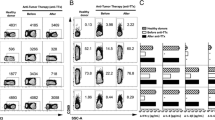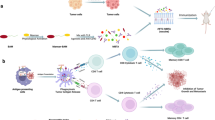Abstract
Introduction
Advanced breast cancer patients, acquired-chemotherapy resistant and in progression, are therapeutically terminal. We tested a recently described medical procedure using a thermostable autohemoderivative purported to inhibit tumor growth possibly through an immunological mechanism of action.
Patients and methods
Metastatic breast cancer patients, chemotherapy-resistant, high CEA and CA 15-3 plasma levels of tumor markers, in progression, were 2-group randomized. Group 1 received the test procedure and Group 2 adequate measures to be comparable control. From 121 included patients, 108 could be evaluated. During 8-month follow-up period, tumor growth, number of cases attaining clinical non-progressive status and mortality were monthly assessed. Immunologic effect was assessed by delayed type hypersensitivity test and lymphocyte proliferation assay. Responding-tumors histopathologies were studied. The proteome of the autologous immunogen was characterized by 2-D electrophoresis.
Results and discussion
In a significant number of cases, the test procedure promoted inhibition of tumor growth, non-progressive disease status, and lower cumulative mortality. These clinical results were associated with polyvalent immunization against several tested antigens: the hemoderivative used for treatment, the blood tumor markers and the derivative obtained from a regulatory lymphocyte population (CD4+CD25+). Interference with this regulatory activity could explain the selective autoimmunity suggested by the histopathology findings in responding tumors. The thermostability could be an essential property of the immunogen hemoderivative.
Conclusion
The thermostable autohemoderivative tested is antigenically polyvalent and promoted a polytargeted immune response associated to a tumor anti-progressive effect, consequently, acting as an autohemoderivative cancer vaccine.
Similar content being viewed by others
References
Lasalvia E, Cucchi S, DeStefani E et al (1995) Autologous induction of tumoral fibrogenesis. Neoplasia 12(1):5–10
Lasalvia E, Cucchi S, Carlevaro T et al (1995) Anti-metastatic␣effect of a blood fraction from cancer patients. (Meeting abstract). Proceedings 31st Annual Meeting of the American Society of Clinical Oncology, Chicago, IL, USA, Abstract No: 730
Lasalvia-Prisco E, Cucchi S, Vázquez J et al (2003) Antitumoral effect of a vaccination procedure with an autologous hemoderivative. Cancer Biol Ther March/April 2(2):155–160
Berd D, Mastrangelo MJ, Engstrong P et al (1982) Augmentation of the human immune response by cyclophosphamide. Cancer Res 42:4862–4866
Leong SP, Enders-Zohr P, Zhou YM et al (1999) Recombinant human granulocyte macrophage-colony stimulating factor (rhGM-CSF) and autologous melanoma vaccine mediate tumor regression in patients with metastatic melanoma. J Immunother 22(2):166–174
Lasalvia-Prisco E, Garcia-Giralt E, Cucchi S et al (2006) Advanced colon cancer: antiprogressive immunotherapy using an autologous hemoderivative. Med Oncol 23(1):91–104
Oken MM, Creech RH, Tormey DC et al (1982) Toxicity and response criteria of the Eastern Cooperative Oncology Group. Am J Clin Oncol 5:649–655
Therasse P, Arbuck SG, Einsenhauer EA et al (2000) New guideline to evaluate the response to treatment in solid tumors. European Organization for Research and Treatment Cancer, National Cancer Institute of the United States, National Cancer Institute of Canada. J Nat Cancer Inst 92:205–216
World Medical Association Declaration of Helsinki: Recommendations guiding medical doctors in biomedical research involving human subjects. Adopted by the 18th World Medical Assembly, Helsinki, Finland, 1964 and as revised in Tokyo, 1975, in Venice, 1983, in Hong Kong, 1989. Version with changes of 1997
PDQ (Physician Data Query) National Cancer Institute, comprehensive cancer database
Garcia-Giralt E, Lasalvia-Prisco E, Cucchi S et al (2005) Breast cancer: role of tumor associated antigens and regulatory cells [CD4+CD25+] as targets of the immune response elicited by an anti-progressive autologous hemoderivative vaccine (Meeting abstract). Proceedings 41st Annual Meeting of the American Society of Clinical Oncology, Orlando, FL, USA, Abstract No. 2589
Wan Fai Ng, Dugan Phillip J, Ponchel FE et al (2001). Human CD4+CD25+ cells: a naturally occurring population of regulatory T cells. Blood 98(9):2736–2744
Gauthier LR, Granotier C, Soria JC et al (2001) Detection of circulating carcinoma cells by telomerase activity. Br J Cancer 84(5):631–635
Langen H, Roeder D, Juranville JF et al (1997) Effect of the protein application mode and the acrylamide concentration on the resolution of protein spots separated by two-dimensional gel electrophoresis. Electrophoresis 18:2085–2090
National Cancer Institute, US: Common terminology criteria for adverse events v3.0 (CTCAE)
Fountoulakis M, Juranville JF, Jiang L et al (2004) Depletion of the high-abundance plasma proteins. Amino Acids 27:249–259
Jones E, Dahm-Vicker M, Simon AK et al (2002) Depletion of CD25+ regulatory cells results in suppression of melanoma growth and induction of autoreactivity in mice. Cancer Immun. 2:1–12
Liyanage UK, Moore TT, Hong-Gu Joo et al (2002) Prevalence of regulatory T cells is increased in peripheral blood and tumor microenvironment of patients with pancreas or breast adenocarcinoma. J Immunol 169:2756–2761
Josic D, Buchacher A, Kannicht C et al (1999) Degradation products of factor VIII which can lead to increased immunogenicity. Vox Sang 77:90–99
Robinson WE Jr, Montefiori DC, Mitchell WM (1988) Antibody-dependent enhancement of human immunodeficiency virus type 1 infection. Lancet 1:790–794
Abeyounis CJ, Milgrom F (1976) A thermostable antigen characteristic for carcinogen-induced rat intestinal tumors. J␣Immunol 116(1):30–34
Lomakin MS, Larin AS, Maiskii IN (1978) Thermostable antigens of malignant tumors and normal tissues of experimental animals [Termostabil’nye antigeny zlokachestvennykh tkanei eksperimental’nykh zhivotnykh]. Biull Eksp Biol Med 85(6):726–728
Lomakin MS, Larin AS, Maiskii IN (1980) Thermo-stable tumor-associated antigens in the serum of tumor-bearing animals and in tissue cultures of malignant tumors [Termostabil’nye opukhole-assotsiirovannye antigeny v syvorotke krovi zhivotnykh-opukholenositelei i v kul’ture tkani zlokachestvennykh opukholei]. Biull Eksp Biol Med 89(4):452–454
Hampton R, Walker M, Marshall J et al (2002). Differential expression of carcinoembryonic antigen (CEA) splice variants in whole blood of colon cancer patients and healthy volunteers: implication for the detection of circulating colon cancer cells. Oncogene 21(51):7817–7823
Burton RM, Hope NJ, Lubbers (1976) A thermostable antigen associated with ovarian cancer. Am J Obstet Gynecol 125(4):472–477
Conry RM, Khazaeli MB, Saleh MN et al (1999) Phase I trial of a recombinant vaccinia virus encoding carcinoembryonic antigen in metastatic adenocarcinoma: comparison of intradermal versus subcutaneous administration. Clin Cancer Res 5(9):2330–2337
Saetang T, Suttijitpaisal P, Ratanabanangkoon K (1998). Preparations of toxic components from Naja kaouthia venom by selective heat denaturation. J Nat Toxins 7(1):37–44
Petrunin DD, Lopukin Iu M, Molodenkov MN et al (1982). Immunochemical identification of thermostable alpha-glycoprotein in blood sera in various immune system diseases. Biull Eksp Biol Med 93(4):66–68
Bruster HTH, Kuntz BME, Scheja JW (1988) Autovaccination plus heat-inactivated autologous plasma in AIDS patients. Lancet 4:1284–1285
Snegotska O (1965) Autovaccines for the treatment of cancer. Folia Clin Int (Barc Spain) 5(6):303–308
Karcher D, Lowenthal A, Stoppie P et al (1984) A serum protein affecting the regulation of the immune system. Neurochem Res 9(10): 1423–1430
Author information
Authors and Affiliations
Corresponding author
Rights and permissions
About this article
Cite this article
Lasalvia-Prisco, E., Vázquez, J., Golomar, W. et al. Advanced breast cancer: anti-progressive immunotherapy using a thermostable autologous hemoderivative. Breast Cancer Res Treat 100, 149–160 (2006). https://doi.org/10.1007/s10549-006-9235-7
Received:
Accepted:
Published:
Issue Date:
DOI: https://doi.org/10.1007/s10549-006-9235-7




